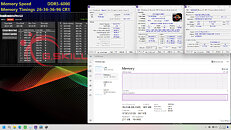
Tech YouTuber Highlights ASRock X870 Motherboard's "Killing" of His Ryzen 9 9950X CPU
Unlucky owners of AMD Ryzen 7 9800X3D processors have encountered major problems that largely involve ASRock motherboards. Throughout early 2025, user feedback provided insight into numerous cases of "catastrophic CPU failures." Members of the official ASRock subreddit have kept track of these unfortunate incidents; now closing in on 200 documented "murdered" specimens. Industry watchdogs reckon that even more disagreements—involving the Zen 5-based 9000X3D series and ASRock B- and X- (AM5) boards—exist outside of this community-aggregated log. At the end of February, ASRock pushed out an important BIOS update—this fix did not resolve all problems. Over a month later, AMD weighed in with their findings—in response, ASRock released another update.
Evidently, Ryzen 7 9800X3D products continue to perish—Tech YES City's Bryan Bilowol has added Team Red's Ryzen 9 9950X model to the mix. The tech YouTuber was surprised by the death of his example; apparently caused by an ASRock X870 Steel Legend mainboard. Standard "Granite Ridge" processors—that lack 3D V-Cache—have received less attention, but observers believe that these non-X3D options are still vulnerable. Bilowol did not personally experience the moment of catastrophe—instead, a friend was borrowing an affected PC build. As demonstrated in a new Tech YES City video post-mortem, the completely dead CPU sported some worrying gray marks. Tech YES City has a fairly large audience, so ASRock leadership will likely be cursing after noticing another uptick in public scrutiny. Past reports have pointed out the manufacturer's belief that too much "misinformation" is being spread. Bilowol surmised that the company is keeping this issue: "under the radar—they seem to be hoping that the issue will just go away." Despite collaborating with ASRock for over a decade, Tech YES City will not pull any punches—await for more gory details in upcoming follow-up investigations.
Evidently, Ryzen 7 9800X3D products continue to perish—Tech YES City's Bryan Bilowol has added Team Red's Ryzen 9 9950X model to the mix. The tech YouTuber was surprised by the death of his example; apparently caused by an ASRock X870 Steel Legend mainboard. Standard "Granite Ridge" processors—that lack 3D V-Cache—have received less attention, but observers believe that these non-X3D options are still vulnerable. Bilowol did not personally experience the moment of catastrophe—instead, a friend was borrowing an affected PC build. As demonstrated in a new Tech YES City video post-mortem, the completely dead CPU sported some worrying gray marks. Tech YES City has a fairly large audience, so ASRock leadership will likely be cursing after noticing another uptick in public scrutiny. Past reports have pointed out the manufacturer's belief that too much "misinformation" is being spread. Bilowol surmised that the company is keeping this issue: "under the radar—they seem to be hoping that the issue will just go away." Despite collaborating with ASRock for over a decade, Tech YES City will not pull any punches—await for more gory details in upcoming follow-up investigations.








































































